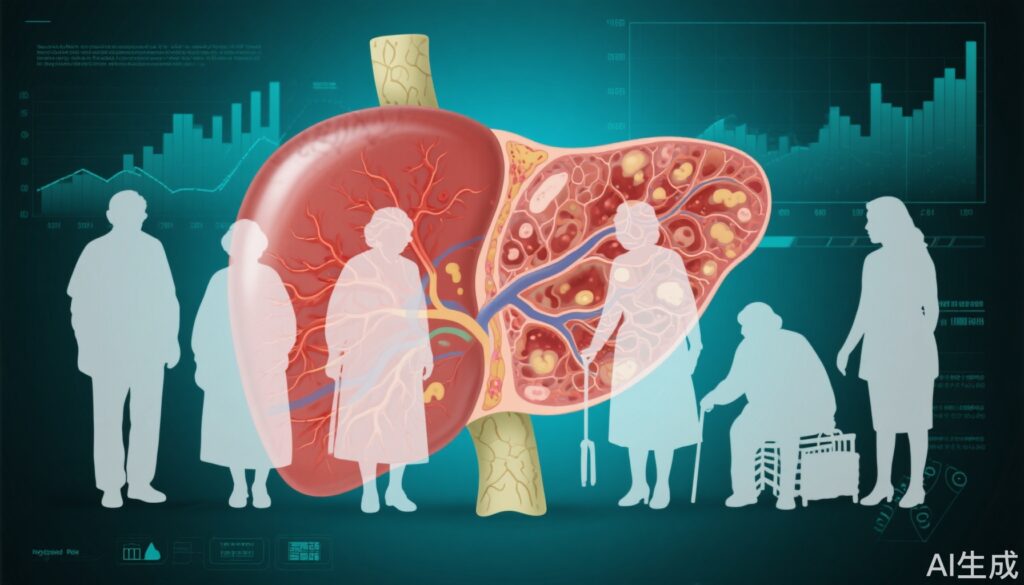Highlights
- Advanced liver fibrosis among heavy drinkers in the US more than doubled from 1999 to 2020, despite stable average alcohol consumption.
- Increased prevalence of metabolic syndrome, aging, female sex, and poverty among heavy drinkers contributed to higher risk.
- Key marker: High Fibrosis-4 (FIB-4) scores, indicating a 25-fold increased risk for liver-related death, rose significantly.
- Findings urge targeted screening and intervention strategies for at-risk groups beyond alcohol quantity alone.
Clinical Background and Disease Burden
Alcohol-related liver disease (ALD) remains a leading cause of preventable morbidity and mortality in the United States, spanning the spectrum from steatosis through steatohepatitis and advanced fibrosis to cirrhosis and hepatocellular carcinoma. Historically, the risk of ALD was primarily attributed to the quantity and duration of alcohol consumption. However, recent trends in liver disease epidemiology, alongside a growing prevalence of metabolic risk factors, suggest a more nuanced and multifactorial risk profile for ALD.
The burden of ALD is substantial: it is the leading indication for liver transplantation among young and middle-aged adults in the US, and liver cirrhosis accounts for more than 50,000 deaths annually in the US alone. Early identification of advanced fibrosis is critical, as progression to cirrhosis dramatically increases risk of liver failure and hepatocellular cancer, and mortality rates rise sharply with advanced disease.
Research Methodology
Lee and colleagues (Clin Gastroenterol Hepatol. 2025) conducted a serial cross-sectional analysis of the National Health and Nutrition Examination Survey (NHANES) data spanning 1999 to 2020. The investigators sought to quantify changes in the prevalence of advanced liver fibrosis among heavy drinkers in the US adult population, defined as consuming at least 20 g/day (women) or 30 g/day (men) of alcohol in the previous year. Individuals with hepatitis B or C were excluded to focus on alcohol-specific liver injury.
The primary outcome was a high FIB-4 score (FIB-4 >2.67 for those aged ≤65 years; >3.25 for >65 years), a validated non-invasive marker of advanced hepatic fibrosis, previously correlated with a 25-fold increased risk of liver-related death. The analysis included 44,628 adults, of whom 2,474 met criteria for heavy alcohol use. The investigators further examined temporal changes in demographic and metabolic risk factors and performed sensitivity analyses restricted to adults aged 35–65 years and to pre-pandemic periods (1999–2018) to ensure robustness.
Key Findings
Among heavy drinkers, the prevalence of high FIB-4 scores more than doubled, rising from 1.8% in 1999–2004 to 4.3% in 2013–2020. This increase was considerably steeper than that observed among non-heavy drinkers (0.8% to 1.4% over the same period). Notably, the average quantity of alcohol consumed by heavy drinkers did not change significantly during this interval, ruling out increased intake as the primary driver of fibrosis risk.
Demographic analysis revealed a marked shift in the risk profile of heavy drinkers over 20 years: the mean age increased, a higher proportion were women, and more were living in poverty. Most strikingly, the prevalence of metabolic syndrome among heavy drinkers rose from 26.4% to 37.6%. Subgroup analyses confirmed that the upward trend in high FIB-4 prevalence persisted even when restricting to adults aged 35–65 or to pre-pandemic years, with liver scarring effectively tripling in some analyses.
These findings suggest that the observed surge in advanced liver fibrosis among heavy drinkers is driven less by changes in drinking behavior and more by an evolving landscape of comorbidities and sociodemographic vulnerability.
| Risk Group | Prevalence of High FIB-4 (1999–2004) | Prevalence of High FIB-4 (2013–2020) |
|---|---|---|
| Heavy Drinkers | 1.8% | 4.3% |
| Non-Heavy Drinkers | 0.8% | 1.4% |
Mechanistic Insights and Biological Plausibility
The synergistic effect of metabolic syndrome and alcohol exposure on liver injury is well described. Insulin resistance, central adiposity, and dyslipidemia heighten hepatic inflammation and oxidative stress, amplifying susceptibility to alcohol-induced hepatotoxicity. Age-related decline in hepatic regenerative capacity and increased prevalence of comorbidities further compound this risk. Women also appear more vulnerable to alcohol’s hepatotoxic effects, potentially due to differences in alcohol metabolism and hormonal factors.
The rise in metabolic syndrome, aging, and poverty among heavy drinkers likely reflects broader population trends, including the obesity epidemic and widening health disparities. These factors together may create a population increasingly “sensitized” to the harmful hepatic effects of a given level of alcohol exposure.
Expert Commentary
Current guidelines from the American Association for the Study of Liver Diseases (AASLD) emphasize the importance of identifying patients at risk for advanced fibrosis, especially when multiple risk factors are present. As noted by Lee and colleagues, the new findings underscore the need to move beyond alcohol quantity alone in risk stratification: clinicians should proactively assess for coexisting metabolic syndrome, age, and socioeconomic risk in any patient with heavy alcohol use.
In the words of the study authors: “Increasing morbidity and mortality due to alcohol-related liver disease may be related to a population more sensitized to the alcohol-related effects in the liver due to increased baseline risk factors.”
Controversies and Limitations
The cross-sectional nature of NHANES precludes causal inference, and reliance on self-reported alcohol intake introduces potential misclassification, especially given the social stigma of heavy drinking. FIB-4, while validated as a non-invasive marker, is an indirect surrogate for hepatic fibrosis and may be influenced by extrahepatic factors (e.g., age, platelet count). The exclusion of persons with viral hepatitis, while clarifying alcohol-specific risk, may limit generalizability to mixed-etiology populations. Nevertheless, sensitivity analyses and large sample size lend credence to the observed trends.
Conclusion
The dramatic rise in advanced liver fibrosis among US heavy drinkers over the past two decades is not attributable to increased alcohol intake, but rather to evolving demographics and rising prevalence of metabolic and socioeconomic risk factors. These findings call for a paradigm shift toward comprehensive, risk-based screening and intervention for ALD, with particular attention to aging adults, women, those with metabolic syndrome, and individuals in poverty. Ongoing surveillance and tailored public health strategies will be essential to stem the rising tide of alcohol-related liver morbidity and mortality.
References
- Gopalkrishnan K, Dodge JL, Lee BP. Significant Liver Disease among Increased Alcohol Consumers More than Doubled from 1999-2020 Alongside Evolving US Population Demographics. Clin Gastroenterol Hepatol. 2025 Jul 19:S1542-3565(25)00610-X. doi: 10.1016/j.cgh.2025.07.006.
- Tapper EB, Parikh ND. Mortality due to cirrhosis and liver cancer in the United States, 1999-2016: observational study. BMJ. 2018;362:k2817.
- Chalasani N, et al. The diagnosis and management of nonalcoholic fatty liver disease: Practice guidance from the American Association for the Study of Liver Diseases. Hepatology. 2018;67:328-357.



